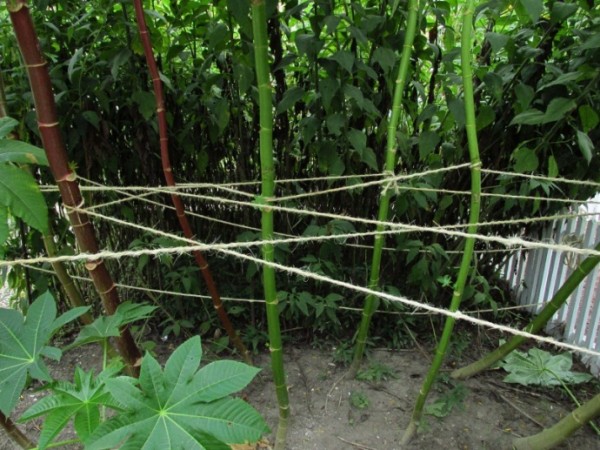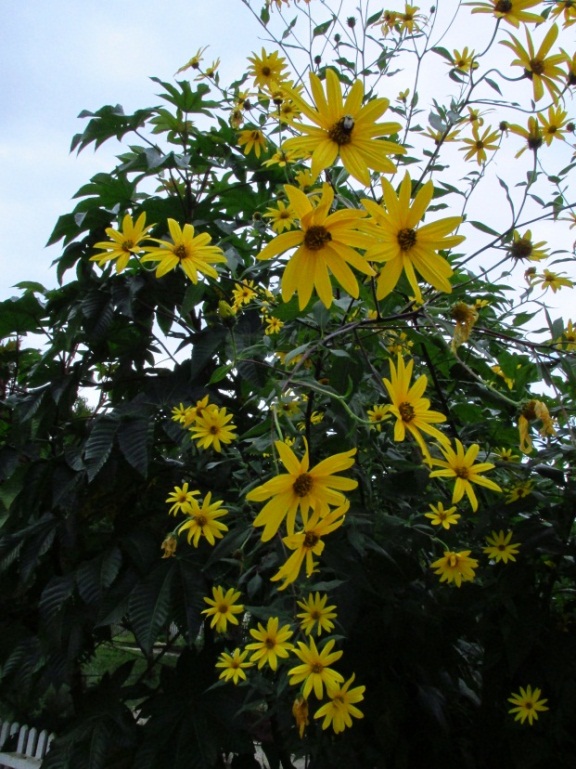
Cleaning Castor Beans after a storm
We have had some violent wind recently which is always a nuisance but not entirely unexpected at this time of year.
Several of the Castor Bean plants (which have soared to nearly 20’ tall!) were blown over onto the asparagus bed. After removing the fallen plants, we have been obliged to tie the stems of the remaining plants together in a grid so that they now support each other when the wind gets up.
Known to the ancients as the Palma Christi (palm of Christ), the seeds of this plant provide that terror known to all recalcitrant children as Castor Oil.
However, the seeds when improperly used, are extremely toxic and even the handling of them may produce dangerous effects, and for this reason we cut them off while still in flower.

Castor Bean trusses
The plant, itself, makes a spectacular specimen and is one of the most asked about plants in the garden.
Growing just beside and nearly as tall as the Castor Bean is the Jerusalem Artichoke. This member of the sunflower family is known to the botanists as Helianthus tuberosa, so named for its edible tubers or roots sometimes called Sunchokes by vegetable merchants.

Jerusalem Artichoke
As for its common name, it is not from Jerusalem at all but is the only native North American vegetable of note, though most Americans have never made the experiment. This may be because of the well-known property commented on by the late Attorney General, John Randolph, who wrote, “they are of a flatulent nature and are apt to cause commotions in the belly.”
We have corralled this towering giant by running stakes and string all around the planting to keep it from falling into the path. It is perhaps a parable that for both of these magnificent monstrosities, too rich a soil produces too weak a product while a poorer soil produces a sturdier stock.
Good Fall morning to you , Wesley,
Well most of my plant containers are now empty. I will be pulling the last of the tomato plants this weekend. My harvest was much better compared to the previous years. Your wonderful guidance is to thank for that. I was wondering if I should plant some sort of cover crop. My containers are 18 inches square. I see in the seed catalogues and web-sites that Winter Rye or Hairy Vetch or a combination of them is best for my Chicago area “cold climate.” I would appreciate your guidance in this matter. I see that both reach 4 to 5 feet in height. So in the Spring how many inches of this height should I turn into my soil? Obviously not the whole 4 to 5 feet.
It has on several nights recently, already been in the high 30’s at night with temps reaching the upper 60s to low 70s.
As always, thank you for sharing your knowledge.
Your humble student,
Chris
Dearest Christine,
At one time I sowed clover as a cover crop in the large bed where I plant flax in the spring and cucurbits in the summer but it proved to be a rabbit attractant so I now sow annual, or winter, rye grass in its place. I do not allow the grass to grow over eight inches tall as the more succulent growth makes for a better compost than the taller, coarser stems. I generally mow it once in the fall and once in the spring just before tilling the bed in late March. Clovers and vetch have the advantage of adding nitrogen to the soil but as I have a near unlimited supply of dung this is not a concern but again, the best compost is derived from the most succulent growth so do not let them grow unchecked.
Congratulations on a successful season this year and with your prudent concern for the quality of your soil future years should be as rewarding.
Yr. obedient servant &c,
Wesley Greene
Dear Wesley,
Thank you for the information. I’ll get a small packet of winter rye seeds.
Enjoy your wonderful Fall weather. We wish we could be there.
Yr. humble student,
Chris